[ad_1]
The vulture looked down through a circling gyre of wings, hundreds of metres to the turquoise sea. From her vantage point she could see the sea churning on the beach, clouds of sand and surf giving way to clear water where the waves were formed, where, too, the whales were born. From up there, she could see 40 or more silky black bodies gliding in the ocean, keeping vigil over newborn calves that bobbed alongside or sidled up to their mother’s nurturing teat.
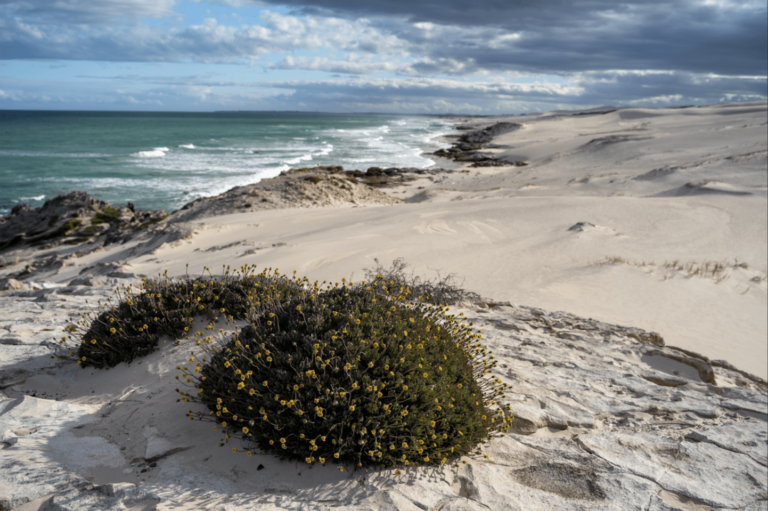
As she circled, the land was revealed, a band of golden beach rising to dunes. On the leeward side, dense coastal forest stopped the sandy march inland. Beyond that, fynbos stretched to a dark, brooding vlei and then climbed the easy slopes in patches of pink, brown, grey green and dusty lime. An ochre road marked the division between wild land and farm, which took on regimented forms of deep green. Then swathes of yellow canola stretched to the horizon, where faded mountains rounded off the scene, their peaks tipped snowy white.
It was the end of July, nursing season for southern right whales off Africa’s most southern shore, and the incubation period for that leviathan of the sky, the Cape vulture. From a viewing platform set into the slope of Potberg, my wife Sarah and I watched the great birds peeling off from the towering gyre where as many as 60 vultures rode the thermals. On their return, we could hear the rush of the wind as they swooped over our heads before alighting on the cliff wall opposite us.
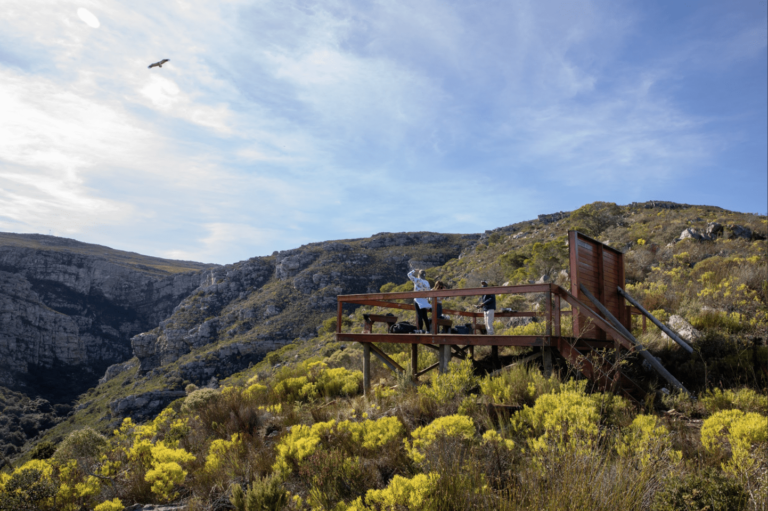
The cliff was shielded from the sun by a deep valley, an ideal nesting place for this growing colony. Our guide, Lizo Msululu, explained that this was one of the few populations that was increasing in number. Here, about 250 vultures breed, a number which has more than doubled in the last decade.
Found only in southern Africa, at around 11 000 individuals, the Cape vulture’s numbers are in decline because of human encroachment, predominantly through farming, which has laid bare their natural habitat. But here on the southern coast, thanks to awareness raised by Cape Nature as to the importance of the species, local communities are seeing the vultures as assets. Farmers on the periphery of the reserve are so impressed with the birds that they place carcasses of deceased livestock in safe locations where they can feed undisturbed.
Our view from the slope of Potsberg was not unlike that seen by the vultures. But those other leviathans, the whales, were out of sight for wingless creatures, so we walked down the slope through colourful fynbos, the trail littered with protea blossoms discarded by baboons that had sucked on the sugary cores.
The beach at De Hoop, with its tall dunes and unobstructed views, is known as one of the best land-based whale-watching sites in the world. Lizo drove us there on a route that took us out of the reserve through rolling farmland where cattle lowed, canola sparkled and wooly sheep suckled newborn lambs.
Steering back into the reserve, the landscape changed once again, transporting us back to a time when man hadn’t dreamed of tilling fields or breeding livestock, but had certainly dreamed of other things.
Stone age hunter-gatherers would have wandered through here. In Blombos Cave not far east, archaeologists led by Professor Christopher Henshilwood discovered that our ancestors had taken shelter there, uncovering the remains of shellfish and small fires lit as much as 100 000 years ago. One of the discoveries was so remarkable that it has changed our understanding of human progress. A small rock was found with six crosshatched lines deliberately drawn on its surface using an ochre crayon. At 73 000 years old, this has set these shores as the place where modern thinking took shape, at a time when only about 10 000 humans lived in Africa.
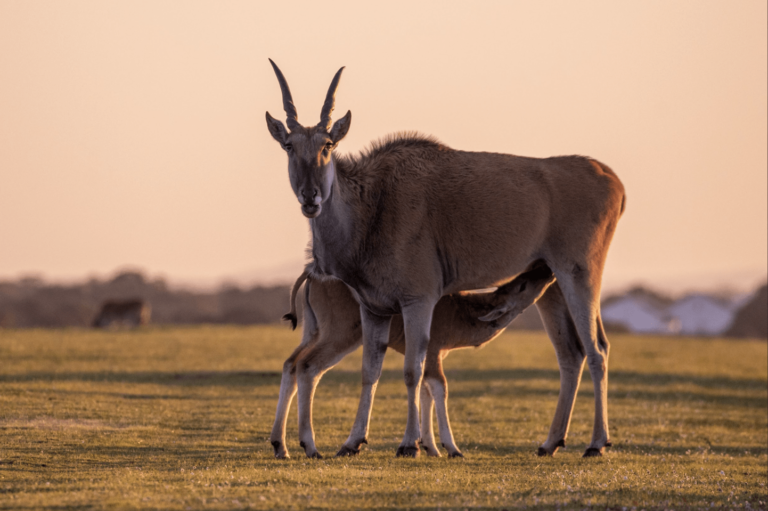
Our ancestors would not have been short of sustenance here. Even today, the variety of flora and fauna is impressive. The diversity of habitats – from multifarious fynbos through wetland, coastal forest and marine ecosystems – supports more than 260 bird species, 86 mammals, 1 500 plant species and a great range of ocean creatures. The second we re-entered the reserve we noticed the change in the variety of birds. A Cape grysbok reared its head above the fynbos, ears all a-twitch. Driving on, we stopped for small herds of bontebok crossing the track. Cape mountain zebra nodded their heads as they ambled alongside our vehicle, and we marvelled at a large herd of eland with their calves on the rich grazing land near the lodges that comprise De Hoop Collection, our home for the weekend.
Closer to the coast the track skirted the vlei as the water fanned outwards, the oldest Ramsar wetland in South Africa, a designation given to wetland sites of international importance. Small in relation to the entire reserve (36 000ha) this 750ha area supports more than 8 000 birds at any one time.
Little grebes bobbed on the water, maccoa ducks guided their chicks between the reeds and a grey heron marched through the shallows, beak poised for fish. The trail veered left at a wall of coastal forest and as we followed the route, the tops of dunes were gradually revealed above the trees which held back their sands. An African hoopoe, well at home in the dense foliage, seemed to be guiding us along as it flitted ahead, stopping to forage on grubs every so often, until it ran out of habitat at Koppie Alleen, where the beach invited gulls, oyster catchers and other wonderful marine beings.
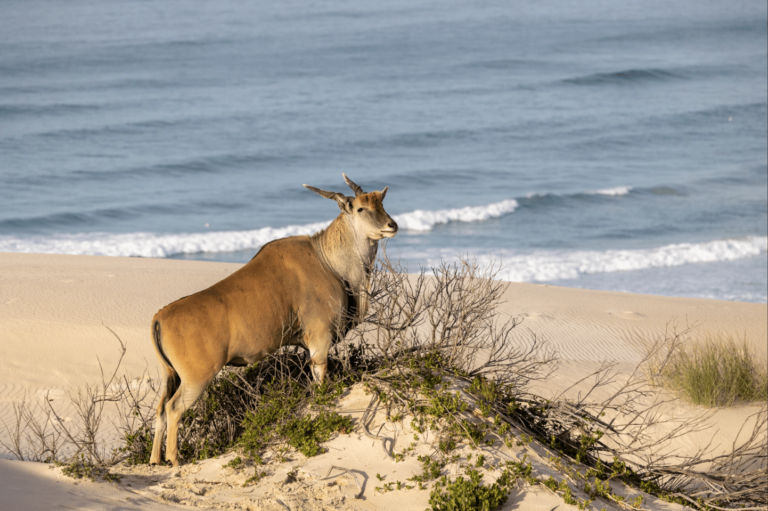
With the sand between our toes, we walked towards the top of the dunes, excited by the prospect of seeing whales. The elevation above the sea was remarkable, making whale spotting much easier, but before we had a chance to look for the creatures another giant caught our eye – a male eland cruising the sand just a few metres below, his trail marked by the deep passage of his hooves.
We were used to seeing these normally shy creatures hiding in thickets or ambling along distant mountain slopes, so it was a treat for us to observe him at close range. He stopped at a small copse of foliage which he nibbled on half-heartedly, then trudged along to the leeward side of the dune where the real forest took hold.
Our attention finally drawn seaward, we saw them immediately, great plumes of mist as a number of southern right whales exhaled. A broad black tail slapped thunderously at the water surface, and in the deeper water further out, a whale vaulted out of the water and crashed through the surface in an eruption of spray. It was soon answered by another about 500 metres to the west, then came its reply, and the tail slapping resumed while all about the breathing plumes rose and fell like a watery musical theatre. Drawn to this spectacle beyond the waves, we’d neglected to look closer, and there, calmly rolling in the crests and troughs behind the breakers were two southern right whales, placid and content, their calves swimming alongside.
After a short while we estimated we had seen at least 25, but Lizo assured us there were more, adding that as many as 70 whales can be seen from here at the height of the breeding season. We realised we’d been exploring De Hoop for little more than an afternoon and it was hard to comprehend what we’d seen in that short time – prodigious life, immense beauty so close at hand.
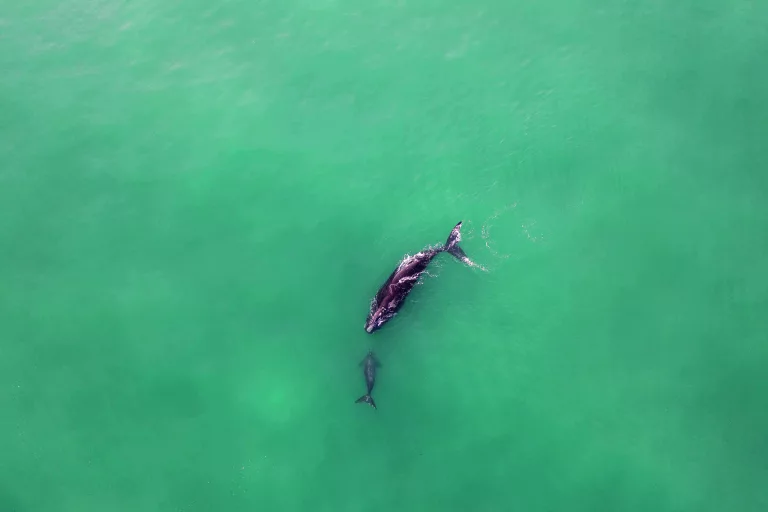
Leaving Koppie Alleen, we drove alongside the forest, determined to return to the beach the next morning. As we left we were watched by the majestic eland standing atop a dune, the vast ocean at his back.
Driving up towards the whitewashed lodgings of De Hoop Collection, we passed the eland herd that munched on the grass, overseen by the immense male. What struck us about the buildings was the sense of an expansive homestead rather than a lodge, and its openness to wildlife. Bontebok grazed on juicy green lawns between family size cottages. Smaller cottages lined the edge of the high river bank where dassies sunned themselves on rocks and birds danced in thickets. The main building, The Opstal, is the original homestead, and within the walls of the courtyard vast fig trees have grown to an extraordinary size so that their girth would need every one of The Opstal’s guests to circle it – and there are plenty of rooms, harking back to the period when this was a grand home.
On the opposite bank of the vlei stood the Melkkamer Manor House, Vlei Cottage and Foreman’s Cottage, golden sandstone walls dating back to the late 1800s, now available to self-catering guests. This was our view from our cottage above the vlei as we relaxed to watch the sun descend over the mouth of the estuary. We heard a Cape zebra tugging at the grass behind us, a reminder that dinner waited at the Fig Tree restaurant. There, we were thrilled to meet proprietor William Stephens, who we’d first met on his boat, The Lady Standford, while exploring a story on Grootbos Private Game Reserve and Walker Bay.
‘Let me show you the wine collection,’ he said after a sumptuous meal. And through a little door in the back of the restaurant, William led us into the original farmstead grain silo now converted into a cellar, where celebrated wines from the nearby valleys circled us.
I confirmed that I was a layman when it comes to wine, but it didn’t stop William from treating us to a decadent-looking red of which I can’t recall the name. Relaxing on the couch near the restaurant’s warm fireplace, we took our first delicious sip. ‘What do you think?’ asked William. All I could say was: ‘It’s gigantic.’
Stay Here
De Hoop Collection
A great variety of accommodations is on offer, from self-catering cottages to fully catered luxury suites, as well as the opportunity to book group stays at the Melkkamer Manor on the other side of the vlei. From R1 600 per unit pn self-catering. 021 422 4522 dehoopcollection.com
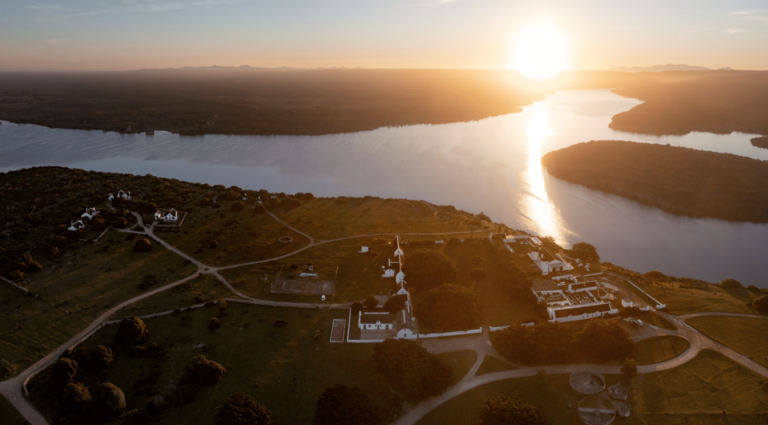
Do this
Land-based whale watching: Guests and day visitors can drive to Koppie Alleen where they can view southern right whales nursing their calves from the high vantage point of the dunes. Whales can be viewed in the winter months between June and November.
Guided Vulture Experience: Guests and day visitors can book a guided tour to the Vulture Deck on Potsberg to watch Cape vultures swoop and soar above. You will hike (+/-1 hour) to reach the deck. Rate includes a packed picnic. Prior arrangement essential (approx 3 hours). 021 422 4522 dehoopcollection.com
Hike, run and MTB through De Hoop’s diverse biomes on five designated trails – from 13km to 55km in length on terrain as easy or challenging as you like. Bring your own wheels, and book a guide if you prefer. 021 422 4522 dehoopcollection.com
De Hoop Collection also hosts the De Hoop Vlei MTB Experience – 2022 dates to be confirmed. overbergmtbevents.co.za
The Whale Trail is one of the most celebrated slackpacking trails in South Africa. The route stretches over 55km, from Potberg to Koppie Alleen, with five comfortable overnight stops in this incredible reserve. Reservations are limited to groups of six or 12. 087 087 8250 capenature.co.za
A version of this article originally appeared in the March 2022 print issue of Getaway.
By Anton Crone
Photography: Anton Crone, Sarah Crone, Supplied
Follow us on social media for more travel news, inspiration, and guides. You can also tag us to be featured.
TikTok | Instagram | Facebook | Twitter
ALSO READ: Embracing sustainable travel and protecting our planet
[ad_2]
Source link
Jarastyle – #Whale #watching #spotting #Cape #Vultures #Hoop
Courtesy : https://www.getaway.co.za/destinations/western-cape/garden-route/whale-watching-and-spotting-cape-vultures-in-de-hoop/

